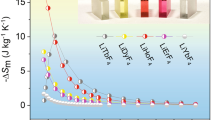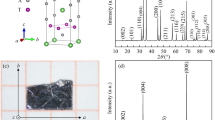Abstract
Magnetic refrigeration techniques based on the magnetocaloric effect (MCE) have recently been demonstrated as a promising alternative to conventional vapour-cycle refrigeration1. In a material displaying the MCE, the alignment of randomly oriented magnetic moments by an external magnetic field results in heating. This heat can then be removed from the MCE material to the ambient atmosphere by heat transfer. If the magnetic field is subsequently turned off, the magnetic moments randomize again, which leads to cooling of the material below the ambient temperature. Here we report the discovery of a large magnetic entropy change in MnFeP0.45As0.55, a material that has a Curie temperature of about 300 K and which allows magnetic refrigeration at room temperature. The magnetic entropy changes reach values of 14.5 J K-1 kg-1 and 18 J K-1 kg-1 for field changes of 2 T and 5 T, respectively. The so-called giant-MCE material Gd5Ge2Si2 (ref. 2) displays similar entropy changes, but can only be used below room temperature. The refrigerant capacity of our material is also significantly greater than that of Gd (ref. 3). The large entropy change is attributed to a field-induced first-order phase transition enhancing the effect of the applied magnetic field.
This is a preview of subscription content, access via your institution
Access options
Subscribe to this journal
Receive 51 print issues and online access
$199.00 per year
only $3.90 per issue
Buy this article
- Purchase on Springer Link
- Instant access to full article PDF
Prices may be subject to local taxes which are calculated during checkout



Similar content being viewed by others
References
Glanz, J. Making a bigger chill with magnets. Science 279, 2045 (1998).
Pecharsky, V. K. & Gschneidner, K. A. Jr Giant magnetocaloric effect in Gd5(Si2Ge2). Phys. Rev. Lett. 78, 4494–4497 (1997).
Gschneidner, K. A. Jr et al. Recent developments in magnetic refrigeration. Mater. Sci. Forum 315–317, 69–76 (1999).
Zimm, C. et al. Description and performance of a near-room temperature magnetic refrigerator. Adv. Cryogen. Eng. 43, 1759–1766 (1998).
Tishin, A. M. in Handbook of Magnetic Materials Vol. 12 (ed. Buschow, K. H. J.) 395–524 (North Holland, Amsterdam, 1999).
Choe, W. et al. Making and breaking covalent bonds across the magnetic transition in the giant magnetocaloric material Gd5(Si2Ge2). Phys. Rev. Lett. 84, 4617–4620 (2000).
Giguere, A. et al. Direct measurement of the “giant” adiabatic temperature change in Gd5(Si2Ge2). Phys. Rev. Lett. 83, 2262–2265 (1999).
Morellon, L. et al. Nature of the first-order antiferromagnetic-ferromagnetic transition in the Ge-rich magnetocaloric compounds Gd5(SixGe1–x)4. Phys. Rev. B 62, 1022–1026 (2000).
Pytlik, L. & Zieba, A. Magnetic phase diagram of MnAs. J. Magn. Magn. Mater. 51, 199–210 (1985).
Zach, R., Guillot, M. & Fruchart, R. The influence of high magnetic fields on the first order magneto-elastic transition in MnFe(P1-yAsy) systems. J. Magn. Magn. Mater. 89, 221–228 (1990).
Bacmann, M. et al. Magnetoelastic transition and antiferro-ferromagnetic ordering in the system MnFeP1-yAsy. J. Magn. Magn. Mater. 134, 59–67 (1994).
Beckman, O. & Lundgren, L. in Handbook of Magnetic Materials (ed. Buschow, K. H. J.) Vol. 6, 181–287 (North Holland, Amsterdam, 1991).
Acknowledgements
We thank A.J. Riemersma for preparation of graphs. Part of this work was performed within the scientific exchange program between the Netherlands and China. This work was financially supported by the Dutch Technology Foundation STW.
Author information
Authors and Affiliations
Corresponding author
Rights and permissions
About this article
Cite this article
Tegus, O., Brück, E., Buschow, K. et al. Transition-metal-based magnetic refrigerants for room-temperature applications. Nature 415, 150–152 (2002). https://doi.org/10.1038/415150a
Received:
Accepted:
Issue Date:
DOI: https://doi.org/10.1038/415150a
This article is cited by
-
Tuning Magnetocaloric Effect in SnMn\(_{2}\) Intermetallic Phase Through sp-Elements Doping
Journal of Superconductivity and Novel Magnetism (2024)
-
Magnetocaloric Effect and Ferromagnetic–Paramagnetic Phase Transition Study of La0.65Ca0.3Gd0.05MnO3
Journal of Low Temperature Physics (2024)
-
Microstructure and magnetocaloric properties of melt-extracted SmGdDyCoAl high-entropy amorphous microwires
Rare Metals (2024)
-
Giant adiabatic temperature change and its direct measurement of a barocaloric effect in a charge-transfer solid
Nature Communications (2023)
-
Calculation of magnetocaloric effect with regard for dependence of heat capacity on magnetic field
Scientific Reports (2023)
Comments
By submitting a comment you agree to abide by our Terms and Community Guidelines. If you find something abusive or that does not comply with our terms or guidelines please flag it as inappropriate.



